LEGL300 Taxation Law Assignment: Residency and Income Analysis
VerifiedAdded on 2023/06/07
|7
|1588
|210
Homework Assignment
AI Summary
This assignment analyzes a taxation law case study, focusing on Tom's residency status and tax liabilities under Australian law. It examines whether Tom is considered an Australian resident based on the "Reside Test", "Domicile Test", and the 183-day test, referencing relevant legislation such as the ITAA 1997 and the Domicile Act 1982, and case law including Miller v FCT and Applegate v FCT. The assignment also assesses the taxability of income earned by Tom from his accounting practice. The analysis considers Tom's employment contract in Brunei, his physical presence, and intentions to determine his tax obligations. The conclusion determines that Tom is an Australian resident and the income from his accounting practice attracts tax liability.
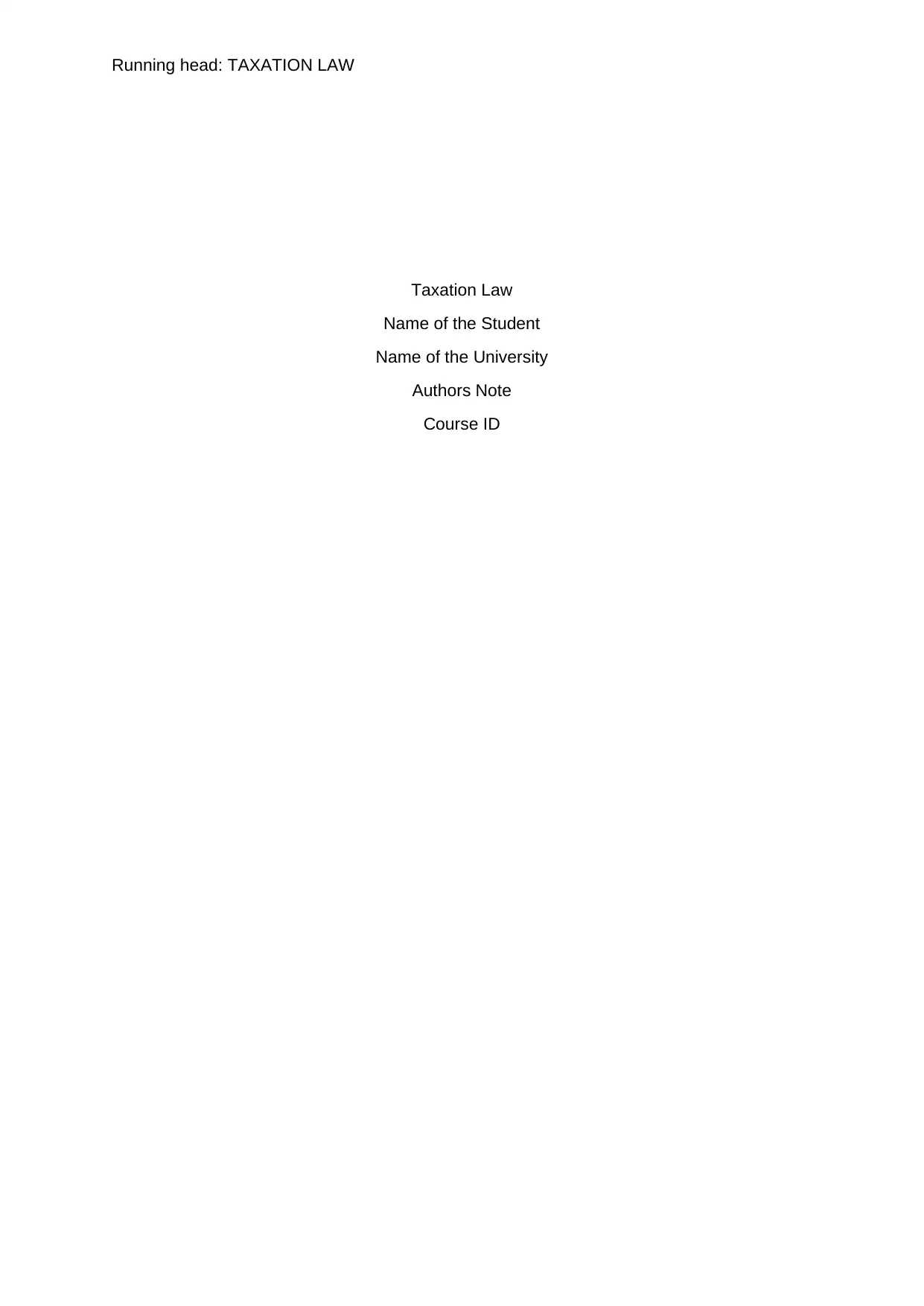
Running head: TAXATION LAW
Taxation Law
Name of the Student
Name of the University
Authors Note
Course ID
Taxation Law
Name of the Student
Name of the University
Authors Note
Course ID
Paraphrase This Document
Need a fresh take? Get an instant paraphrase of this document with our AI Paraphraser
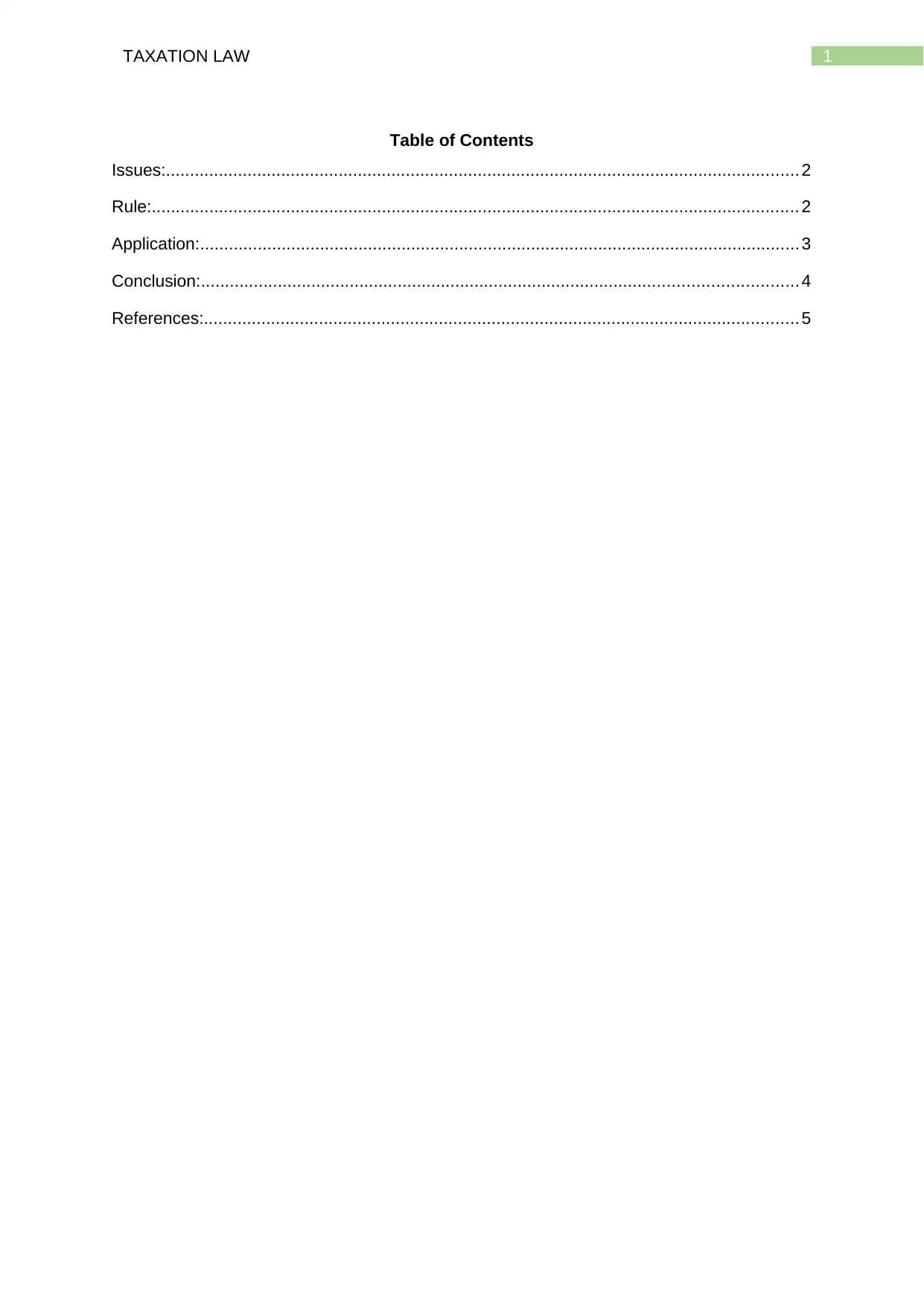
1TAXATION LAW
Table of Contents
Issues:.................................................................................................................................... 2
Rule:....................................................................................................................................... 2
Application:............................................................................................................................. 3
Conclusion:............................................................................................................................ 4
References:............................................................................................................................ 5
Table of Contents
Issues:.................................................................................................................................... 2
Rule:....................................................................................................................................... 2
Application:............................................................................................................................. 3
Conclusion:............................................................................................................................ 4
References:............................................................................................................................ 5
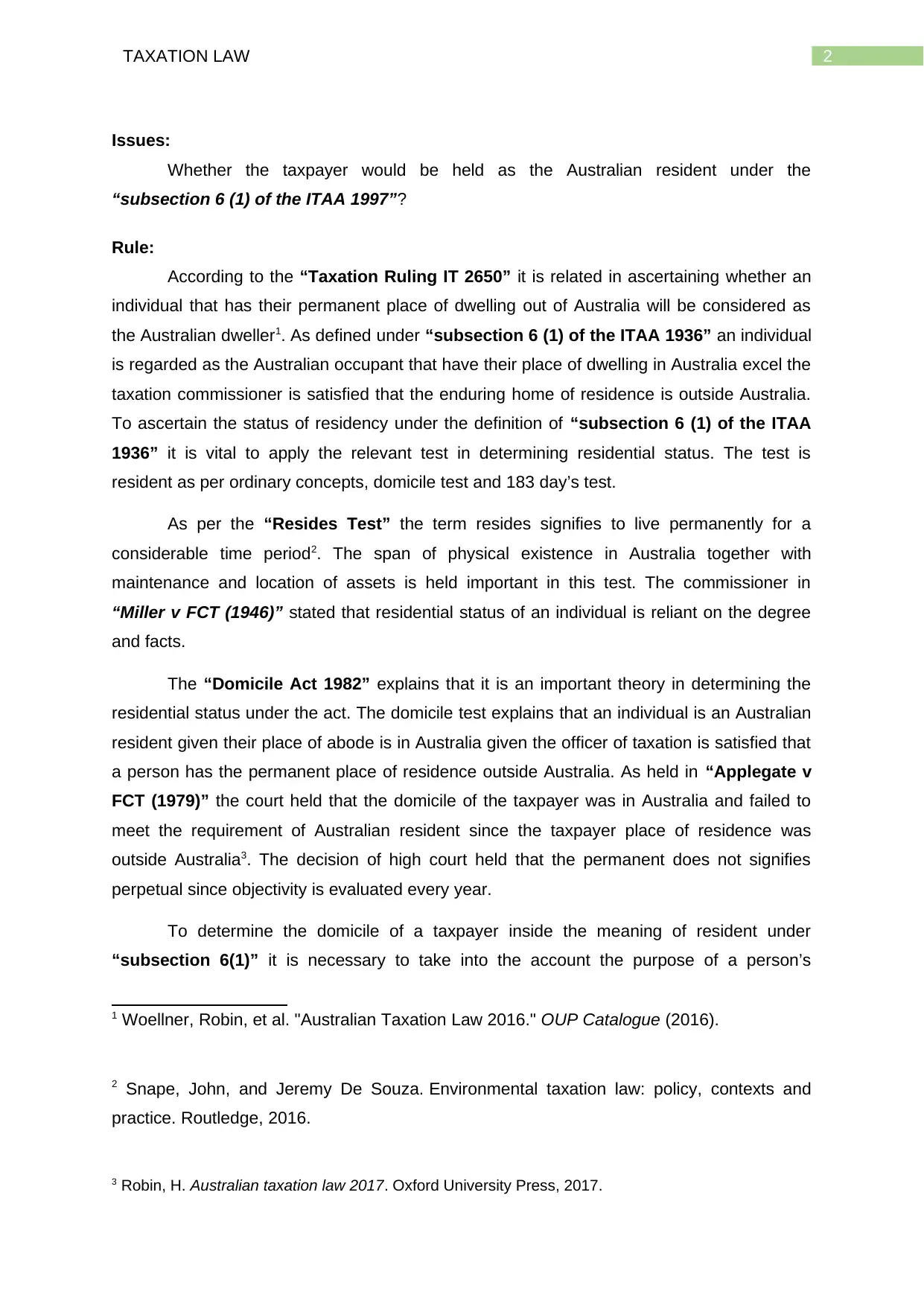
2TAXATION LAW
Issues:
Whether the taxpayer would be held as the Australian resident under the
“subsection 6 (1) of the ITAA 1997”?
Rule:
According to the “Taxation Ruling IT 2650” it is related in ascertaining whether an
individual that has their permanent place of dwelling out of Australia will be considered as
the Australian dweller1. As defined under “subsection 6 (1) of the ITAA 1936” an individual
is regarded as the Australian occupant that have their place of dwelling in Australia excel the
taxation commissioner is satisfied that the enduring home of residence is outside Australia.
To ascertain the status of residency under the definition of “subsection 6 (1) of the ITAA
1936” it is vital to apply the relevant test in determining residential status. The test is
resident as per ordinary concepts, domicile test and 183 day’s test.
As per the “Resides Test” the term resides signifies to live permanently for a
considerable time period2. The span of physical existence in Australia together with
maintenance and location of assets is held important in this test. The commissioner in
“Miller v FCT (1946)” stated that residential status of an individual is reliant on the degree
and facts.
The “Domicile Act 1982” explains that it is an important theory in determining the
residential status under the act. The domicile test explains that an individual is an Australian
resident given their place of abode is in Australia given the officer of taxation is satisfied that
a person has the permanent place of residence outside Australia. As held in “Applegate v
FCT (1979)” the court held that the domicile of the taxpayer was in Australia and failed to
meet the requirement of Australian resident since the taxpayer place of residence was
outside Australia3. The decision of high court held that the permanent does not signifies
perpetual since objectivity is evaluated every year.
To determine the domicile of a taxpayer inside the meaning of resident under
“subsection 6(1)” it is necessary to take into the account the purpose of a person’s
1 Woellner, Robin, et al. "Australian Taxation Law 2016." OUP Catalogue (2016).
2 Snape, John, and Jeremy De Souza. Environmental taxation law: policy, contexts and
practice. Routledge, 2016.
3 Robin, H. Australian taxation law 2017. Oxford University Press, 2017.
Issues:
Whether the taxpayer would be held as the Australian resident under the
“subsection 6 (1) of the ITAA 1997”?
Rule:
According to the “Taxation Ruling IT 2650” it is related in ascertaining whether an
individual that has their permanent place of dwelling out of Australia will be considered as
the Australian dweller1. As defined under “subsection 6 (1) of the ITAA 1936” an individual
is regarded as the Australian occupant that have their place of dwelling in Australia excel the
taxation commissioner is satisfied that the enduring home of residence is outside Australia.
To ascertain the status of residency under the definition of “subsection 6 (1) of the ITAA
1936” it is vital to apply the relevant test in determining residential status. The test is
resident as per ordinary concepts, domicile test and 183 day’s test.
As per the “Resides Test” the term resides signifies to live permanently for a
considerable time period2. The span of physical existence in Australia together with
maintenance and location of assets is held important in this test. The commissioner in
“Miller v FCT (1946)” stated that residential status of an individual is reliant on the degree
and facts.
The “Domicile Act 1982” explains that it is an important theory in determining the
residential status under the act. The domicile test explains that an individual is an Australian
resident given their place of abode is in Australia given the officer of taxation is satisfied that
a person has the permanent place of residence outside Australia. As held in “Applegate v
FCT (1979)” the court held that the domicile of the taxpayer was in Australia and failed to
meet the requirement of Australian resident since the taxpayer place of residence was
outside Australia3. The decision of high court held that the permanent does not signifies
perpetual since objectivity is evaluated every year.
To determine the domicile of a taxpayer inside the meaning of resident under
“subsection 6(1)” it is necessary to take into the account the purpose of a person’s
1 Woellner, Robin, et al. "Australian Taxation Law 2016." OUP Catalogue (2016).
2 Snape, John, and Jeremy De Souza. Environmental taxation law: policy, contexts and
practice. Routledge, 2016.
3 Robin, H. Australian taxation law 2017. Oxford University Press, 2017.
⊘ This is a preview!⊘
Do you want full access?
Subscribe today to unlock all pages.

Trusted by 1+ million students worldwide
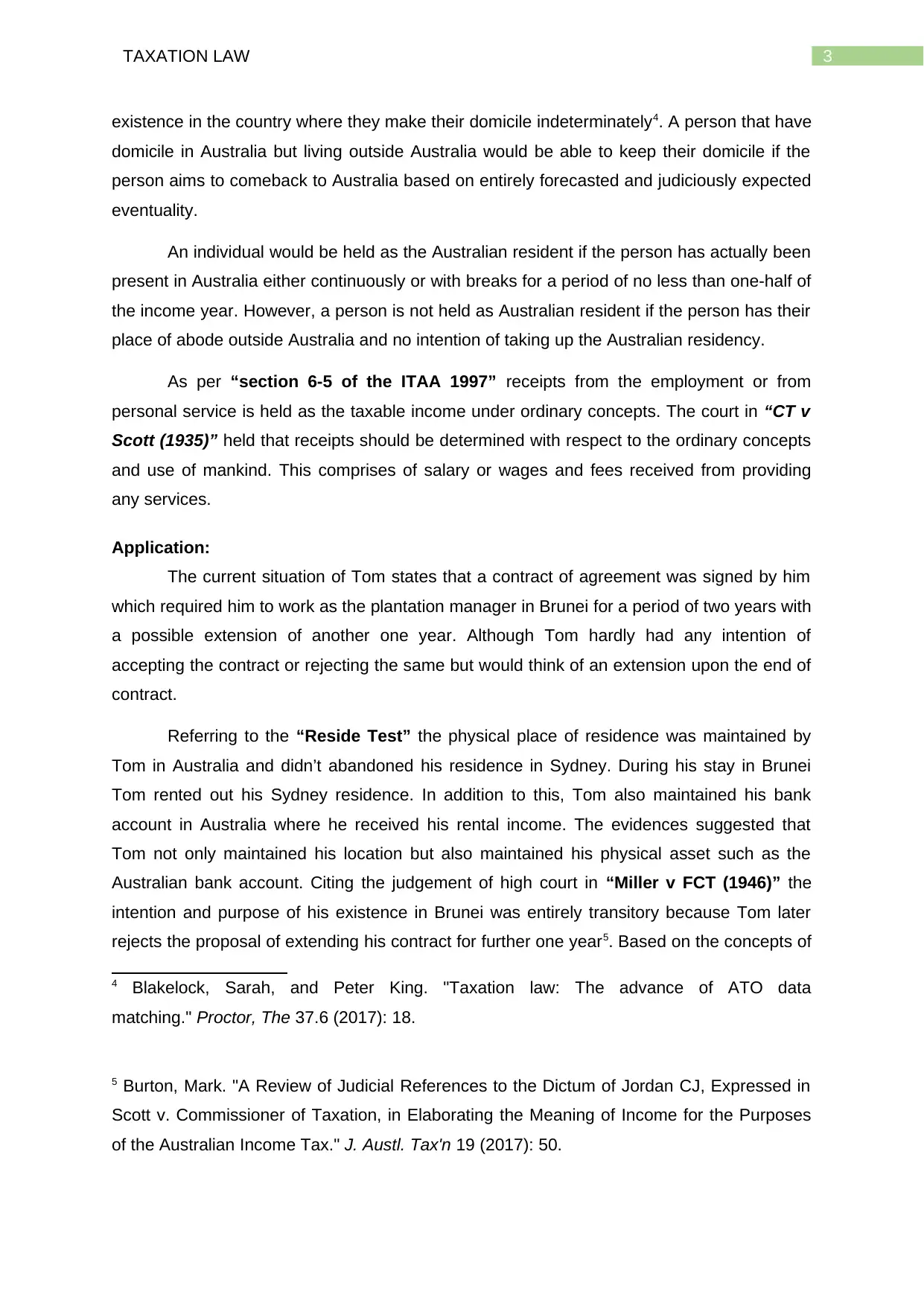
3TAXATION LAW
existence in the country where they make their domicile indeterminately4. A person that have
domicile in Australia but living outside Australia would be able to keep their domicile if the
person aims to comeback to Australia based on entirely forecasted and judiciously expected
eventuality.
An individual would be held as the Australian resident if the person has actually been
present in Australia either continuously or with breaks for a period of no less than one-half of
the income year. However, a person is not held as Australian resident if the person has their
place of abode outside Australia and no intention of taking up the Australian residency.
As per “section 6-5 of the ITAA 1997” receipts from the employment or from
personal service is held as the taxable income under ordinary concepts. The court in “CT v
Scott (1935)” held that receipts should be determined with respect to the ordinary concepts
and use of mankind. This comprises of salary or wages and fees received from providing
any services.
Application:
The current situation of Tom states that a contract of agreement was signed by him
which required him to work as the plantation manager in Brunei for a period of two years with
a possible extension of another one year. Although Tom hardly had any intention of
accepting the contract or rejecting the same but would think of an extension upon the end of
contract.
Referring to the “Reside Test” the physical place of residence was maintained by
Tom in Australia and didn’t abandoned his residence in Sydney. During his stay in Brunei
Tom rented out his Sydney residence. In addition to this, Tom also maintained his bank
account in Australia where he received his rental income. The evidences suggested that
Tom not only maintained his location but also maintained his physical asset such as the
Australian bank account. Citing the judgement of high court in “Miller v FCT (1946)” the
intention and purpose of his existence in Brunei was entirely transitory because Tom later
rejects the proposal of extending his contract for further one year5. Based on the concepts of
4 Blakelock, Sarah, and Peter King. "Taxation law: The advance of ATO data
matching." Proctor, The 37.6 (2017): 18.
5 Burton, Mark. "A Review of Judicial References to the Dictum of Jordan CJ, Expressed in
Scott v. Commissioner of Taxation, in Elaborating the Meaning of Income for the Purposes
of the Australian Income Tax." J. Austl. Tax'n 19 (2017): 50.
existence in the country where they make their domicile indeterminately4. A person that have
domicile in Australia but living outside Australia would be able to keep their domicile if the
person aims to comeback to Australia based on entirely forecasted and judiciously expected
eventuality.
An individual would be held as the Australian resident if the person has actually been
present in Australia either continuously or with breaks for a period of no less than one-half of
the income year. However, a person is not held as Australian resident if the person has their
place of abode outside Australia and no intention of taking up the Australian residency.
As per “section 6-5 of the ITAA 1997” receipts from the employment or from
personal service is held as the taxable income under ordinary concepts. The court in “CT v
Scott (1935)” held that receipts should be determined with respect to the ordinary concepts
and use of mankind. This comprises of salary or wages and fees received from providing
any services.
Application:
The current situation of Tom states that a contract of agreement was signed by him
which required him to work as the plantation manager in Brunei for a period of two years with
a possible extension of another one year. Although Tom hardly had any intention of
accepting the contract or rejecting the same but would think of an extension upon the end of
contract.
Referring to the “Reside Test” the physical place of residence was maintained by
Tom in Australia and didn’t abandoned his residence in Sydney. During his stay in Brunei
Tom rented out his Sydney residence. In addition to this, Tom also maintained his bank
account in Australia where he received his rental income. The evidences suggested that
Tom not only maintained his location but also maintained his physical asset such as the
Australian bank account. Citing the judgement of high court in “Miller v FCT (1946)” the
intention and purpose of his existence in Brunei was entirely transitory because Tom later
rejects the proposal of extending his contract for further one year5. Based on the concepts of
4 Blakelock, Sarah, and Peter King. "Taxation law: The advance of ATO data
matching." Proctor, The 37.6 (2017): 18.
5 Burton, Mark. "A Review of Judicial References to the Dictum of Jordan CJ, Expressed in
Scott v. Commissioner of Taxation, in Elaborating the Meaning of Income for the Purposes
of the Australian Income Tax." J. Austl. Tax'n 19 (2017): 50.
Paraphrase This Document
Need a fresh take? Get an instant paraphrase of this document with our AI Paraphraser
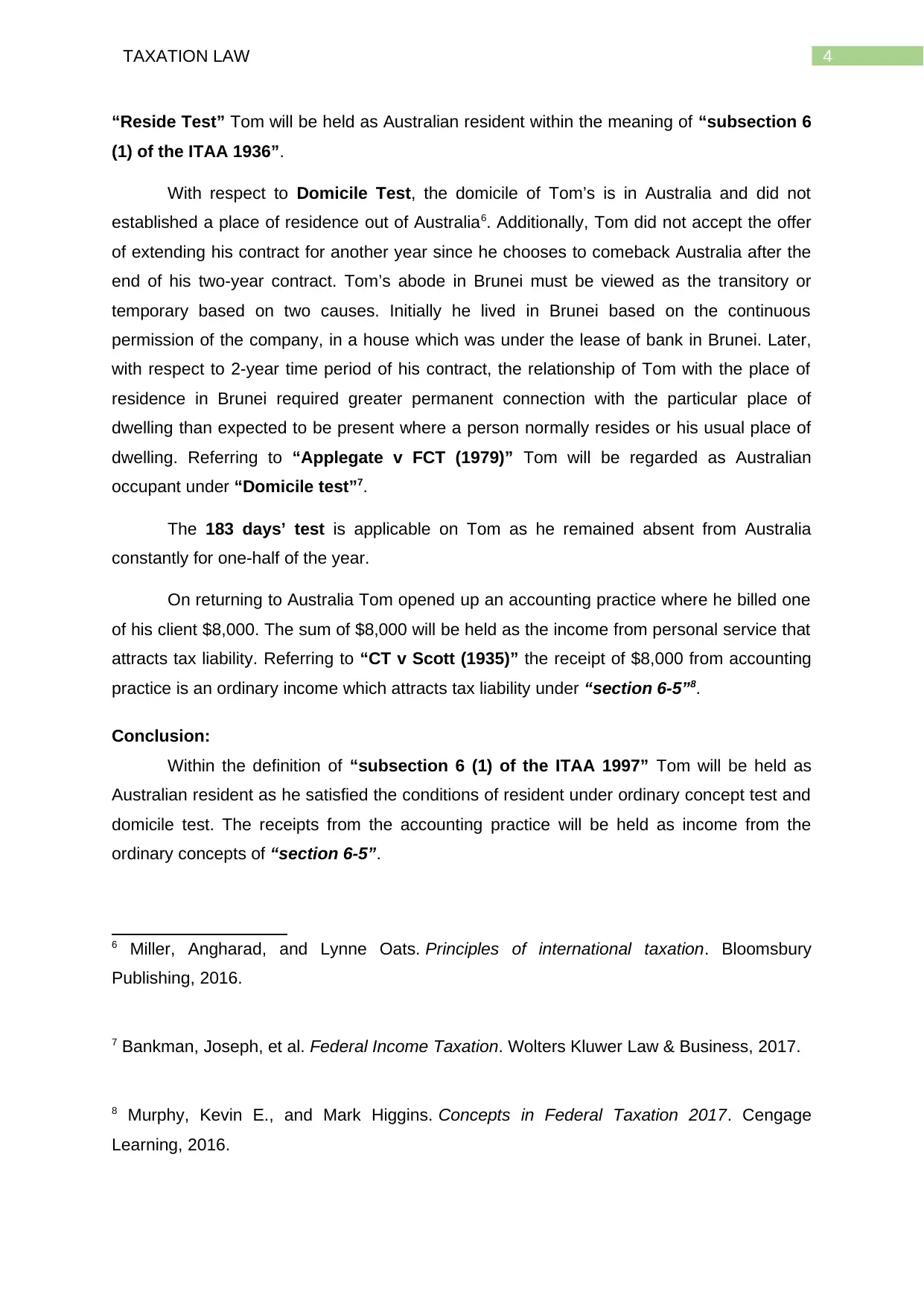
4TAXATION LAW
“Reside Test” Tom will be held as Australian resident within the meaning of “subsection 6
(1) of the ITAA 1936”.
With respect to Domicile Test, the domicile of Tom’s is in Australia and did not
established a place of residence out of Australia6. Additionally, Tom did not accept the offer
of extending his contract for another year since he chooses to comeback Australia after the
end of his two-year contract. Tom’s abode in Brunei must be viewed as the transitory or
temporary based on two causes. Initially he lived in Brunei based on the continuous
permission of the company, in a house which was under the lease of bank in Brunei. Later,
with respect to 2-year time period of his contract, the relationship of Tom with the place of
residence in Brunei required greater permanent connection with the particular place of
dwelling than expected to be present where a person normally resides or his usual place of
dwelling. Referring to “Applegate v FCT (1979)” Tom will be regarded as Australian
occupant under “Domicile test”7.
The 183 days’ test is applicable on Tom as he remained absent from Australia
constantly for one-half of the year.
On returning to Australia Tom opened up an accounting practice where he billed one
of his client $8,000. The sum of $8,000 will be held as the income from personal service that
attracts tax liability. Referring to “CT v Scott (1935)” the receipt of $8,000 from accounting
practice is an ordinary income which attracts tax liability under “section 6-5”8.
Conclusion:
Within the definition of “subsection 6 (1) of the ITAA 1997” Tom will be held as
Australian resident as he satisfied the conditions of resident under ordinary concept test and
domicile test. The receipts from the accounting practice will be held as income from the
ordinary concepts of “section 6-5”.
6 Miller, Angharad, and Lynne Oats. Principles of international taxation. Bloomsbury
Publishing, 2016.
7 Bankman, Joseph, et al. Federal Income Taxation. Wolters Kluwer Law & Business, 2017.
8 Murphy, Kevin E., and Mark Higgins. Concepts in Federal Taxation 2017. Cengage
Learning, 2016.
“Reside Test” Tom will be held as Australian resident within the meaning of “subsection 6
(1) of the ITAA 1936”.
With respect to Domicile Test, the domicile of Tom’s is in Australia and did not
established a place of residence out of Australia6. Additionally, Tom did not accept the offer
of extending his contract for another year since he chooses to comeback Australia after the
end of his two-year contract. Tom’s abode in Brunei must be viewed as the transitory or
temporary based on two causes. Initially he lived in Brunei based on the continuous
permission of the company, in a house which was under the lease of bank in Brunei. Later,
with respect to 2-year time period of his contract, the relationship of Tom with the place of
residence in Brunei required greater permanent connection with the particular place of
dwelling than expected to be present where a person normally resides or his usual place of
dwelling. Referring to “Applegate v FCT (1979)” Tom will be regarded as Australian
occupant under “Domicile test”7.
The 183 days’ test is applicable on Tom as he remained absent from Australia
constantly for one-half of the year.
On returning to Australia Tom opened up an accounting practice where he billed one
of his client $8,000. The sum of $8,000 will be held as the income from personal service that
attracts tax liability. Referring to “CT v Scott (1935)” the receipt of $8,000 from accounting
practice is an ordinary income which attracts tax liability under “section 6-5”8.
Conclusion:
Within the definition of “subsection 6 (1) of the ITAA 1997” Tom will be held as
Australian resident as he satisfied the conditions of resident under ordinary concept test and
domicile test. The receipts from the accounting practice will be held as income from the
ordinary concepts of “section 6-5”.
6 Miller, Angharad, and Lynne Oats. Principles of international taxation. Bloomsbury
Publishing, 2016.
7 Bankman, Joseph, et al. Federal Income Taxation. Wolters Kluwer Law & Business, 2017.
8 Murphy, Kevin E., and Mark Higgins. Concepts in Federal Taxation 2017. Cengage
Learning, 2016.
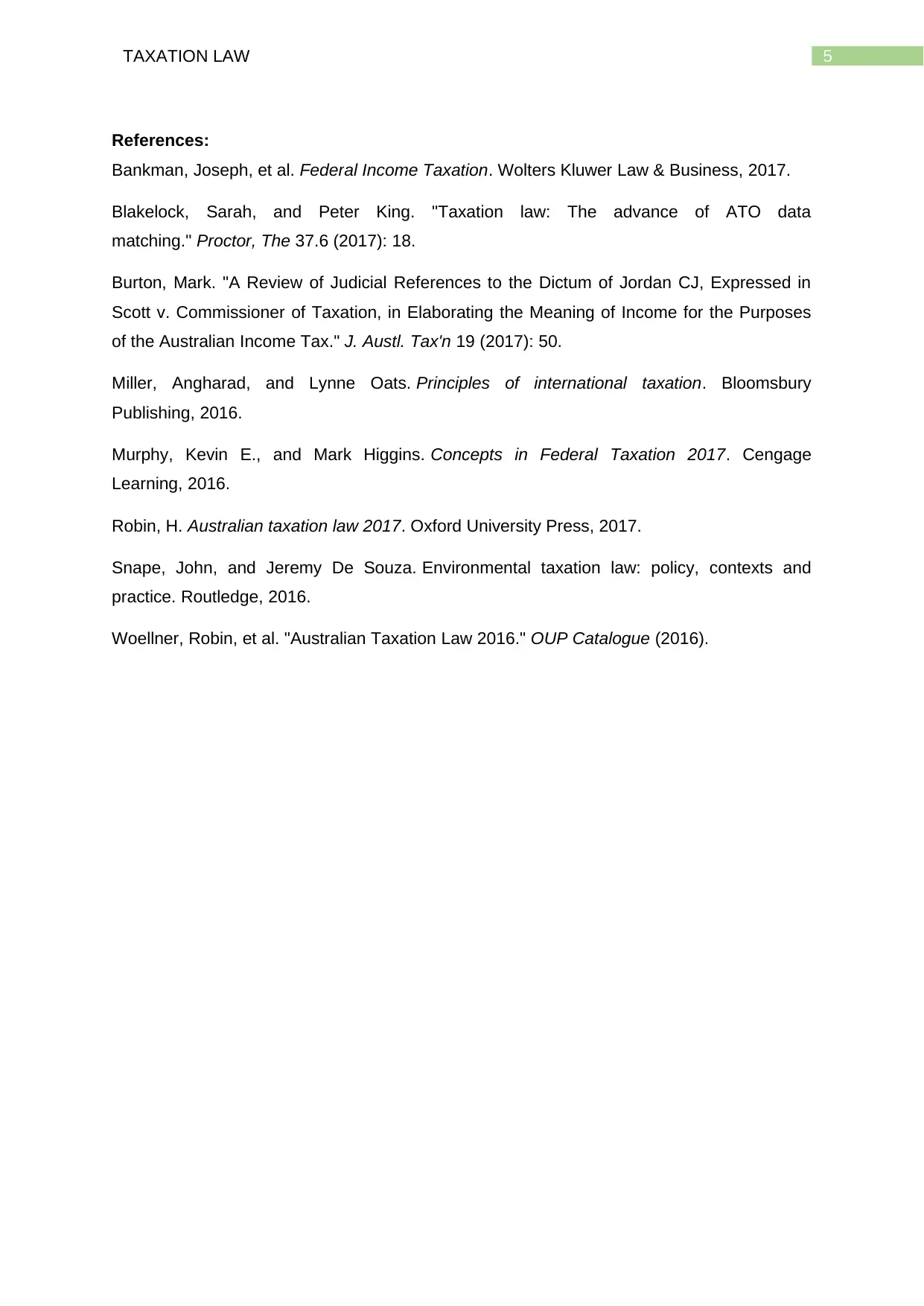
5TAXATION LAW
References:
Bankman, Joseph, et al. Federal Income Taxation. Wolters Kluwer Law & Business, 2017.
Blakelock, Sarah, and Peter King. "Taxation law: The advance of ATO data
matching." Proctor, The 37.6 (2017): 18.
Burton, Mark. "A Review of Judicial References to the Dictum of Jordan CJ, Expressed in
Scott v. Commissioner of Taxation, in Elaborating the Meaning of Income for the Purposes
of the Australian Income Tax." J. Austl. Tax'n 19 (2017): 50.
Miller, Angharad, and Lynne Oats. Principles of international taxation. Bloomsbury
Publishing, 2016.
Murphy, Kevin E., and Mark Higgins. Concepts in Federal Taxation 2017. Cengage
Learning, 2016.
Robin, H. Australian taxation law 2017. Oxford University Press, 2017.
Snape, John, and Jeremy De Souza. Environmental taxation law: policy, contexts and
practice. Routledge, 2016.
Woellner, Robin, et al. "Australian Taxation Law 2016." OUP Catalogue (2016).
References:
Bankman, Joseph, et al. Federal Income Taxation. Wolters Kluwer Law & Business, 2017.
Blakelock, Sarah, and Peter King. "Taxation law: The advance of ATO data
matching." Proctor, The 37.6 (2017): 18.
Burton, Mark. "A Review of Judicial References to the Dictum of Jordan CJ, Expressed in
Scott v. Commissioner of Taxation, in Elaborating the Meaning of Income for the Purposes
of the Australian Income Tax." J. Austl. Tax'n 19 (2017): 50.
Miller, Angharad, and Lynne Oats. Principles of international taxation. Bloomsbury
Publishing, 2016.
Murphy, Kevin E., and Mark Higgins. Concepts in Federal Taxation 2017. Cengage
Learning, 2016.
Robin, H. Australian taxation law 2017. Oxford University Press, 2017.
Snape, John, and Jeremy De Souza. Environmental taxation law: policy, contexts and
practice. Routledge, 2016.
Woellner, Robin, et al. "Australian Taxation Law 2016." OUP Catalogue (2016).
⊘ This is a preview!⊘
Do you want full access?
Subscribe today to unlock all pages.

Trusted by 1+ million students worldwide

6TAXATION LAW
1 out of 7
Related Documents
Your All-in-One AI-Powered Toolkit for Academic Success.
+13062052269
info@desklib.com
Available 24*7 on WhatsApp / Email
![[object Object]](/_next/static/media/star-bottom.7253800d.svg)
Unlock your academic potential
Copyright © 2020–2025 A2Z Services. All Rights Reserved. Developed and managed by ZUCOL.





